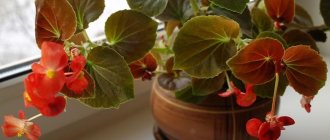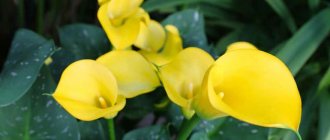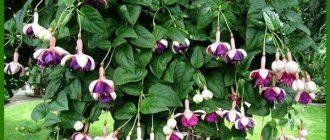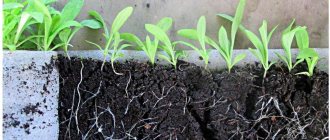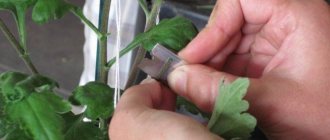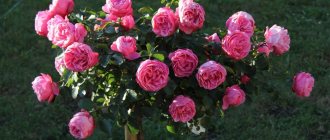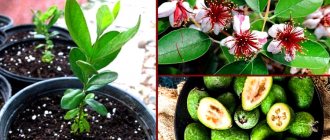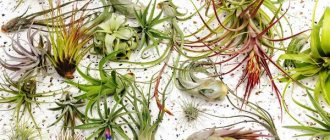Outdoor begonia is an ideal plant for decorating gardens, terraces, and garden paths. It can be planted in open ground, grown in containers and pots, and used for effective landscaping of balconies and local areas. Gardeners usually prefer annual begonias, since their buds bloom in early spring. In this article we will look at the varieties of begonia, its popular types, how to plant begonia, the features of growing flowers in flowerpots and much other interesting information.
Plant characteristics
Tuberous begonia (Begonia tuberhybrida) is an unpretentious perennial plant. It looks great anywhere, is very versatile and extremely popular. Begonias were first described in history in 1690 by the French botanist Charles Plumiere. The name comes from another French plant expert, Michel Begon, and was used as a tribute. However, the delicate colorful flowers were known much earlier - according to historical sources, they were grown in China as early as the 14th century.
Numerous varieties make the begonia flower widespread and very popular among gardeners. The plant has been known in Europe for many years. Garden begonia flowers grow well in our climatic conditions; many varieties are created by crossing numerous species from Africa and the Andes.
Begonia is a small plant, the length of its shoots rarely exceeds 30 cm. The flower tends to branch quickly, which makes it even more attractive. It looks like a small bush decorated with beautiful flowers. The leaves are noteworthy - short, heart-shaped, fleshy and shiny, planted on rather long petioles.
Outdoor begonia blooms from June until the first frost, so it becomes the best decoration for the summer and autumn garden. Winter or ever-blooming begonia (Begonia x semperflorens-cultorum) is also known. Tuberous begonia owes its name to the fact that it forms underground tubers with the help of which it reproduces. Plants planted in the garden look very impressive. These flowers are also suitable for growing in pots, outdoor containers, and on balconies.
Choosing a place for a flower garden
First of all, you need to think about choosing a place for a flower garden and the type of flower garden. You need to think about what you want to decorate. The choice of plants depends on the choice of location. If the place is sunny, then light-loving species are needed, if there is shade, then shade-tolerant ones. If there is little space, then small plants are selected accordingly; if there is a lot, then along with miniature ones, large ones are also suitable. You also need to think about how much time and effort you are going to be able to devote to your plants and how much money you can spend on purchasing and caring for them. If you are not limited in funds and time, then your choice is unlimited. If you don’t have a lot of money, then it’s logical to choose inexpensive plants. If there is little time, then the most unpretentious ones are chosen. Inexpensive and unpretentious are not always the same thing.
Varieties and varieties of begonias with photos
It is difficult to describe in words what begonia flowers look like. Plant varieties represent a huge collection of different colors and shapes.
There are 2 popular garden species that can be grown outdoors:
- Tuberous (Begonia x tuberhybrida) with large multi-colored flowers.
- Semperflorens – ever-blooming or ever-blooming (Begonia semperflorens). Grows up to 50 cm in height, blooms from spring to autumn.
The following species are usually grown at home:
- royal (Begonia rex) - with beautifully colored leaves;
- winter (Begonia x hiemalis) - with extremely noble pink inflorescences.
Some species are annuals and require annual planting, while others, such as tuberous begonias, can overwinter.
There are tuberous varieties with semi-double, double and single flowers. Also popular is cascading ampelous begonia with much smaller flowers. Royal begonia does not produce many flowers; its leaves give it a decorative appearance.
Begonia varieties are difficult to count, their number is huge, as well as the number of variations and varieties. In the house and garden, standard tuberous begonia is most often grown, which is divided into 3 main groups. The criterion for division is the type and size of flowers.
- Large-flowered begonia (Begonia x tuberhybrida grandiflora) is the most popular variety. It differs in flower color and structure - they can have very jagged, fringed edges. The variety produces beautiful, double flowers, a bit like roses. The inflorescences have a diameter of up to 20-30 cm, although when grown on a windowsill they usually do not reach a large size. The flowers are white, yellow, pink, orange, red, burgundy, and there are two-color varieties, for example, white with a dark red border.
- Ampelous begonias are distinguished by the beautiful shape of the bush; they form thin, long, drooping stems. Hanging varieties are better suited for the balcony, where they look great in boxes or hanging pots - flowerpots. The shoots are covered with thin flowers that form large inflorescences and look very attractive. Varieties of hanging begonias differ in color and flower shape - some are simple, others are double, the most magnificent. Cascade begonia is the best plant for shaded balconies.
- Multiflora Multiflora (Begonia Multiflora Maxima) is not a garden begonia, the plant is suitable for a balcony, has tiny flowers. It looks great on the windowsill. Like the royal begonia, this is one of the most popular plants with decorative leaves covered with hairs and painted in different, most beautiful colors and patterns.
Popular varieties
| Name and description of the variety | Photo |
| Camellia bicolor (Bicolor Camellia) pink. The best place is a slightly shaded position, protected from the winds. The soil should be humus, permeable, and moist. Blooms in July – October. Grows up to 25-40 cm in height. | |
| Fimbriata white. White color. Variety: fimbriata - shaggy. Height: 20-25 cm. Flowering: June-September. Leaves in the shape of a heart. Flowers grow in the corners of the upper leaves, have a diameter of up to 12 cm, the petals are curled. | |
| Red fimbriata (Begonia fimbriata). Color: red. Variety: fimbriata - shaggy. Height: 20-25 cm. Flowering: June-September. The flowers are red, up to 12 cm in diameter. | |
| Orange fimbriata (Begonia fimbriata). Variety: fimbriata - shaggy. Orange color. | |
| Fimbriata pink (Fimbriata). Pink fimbriata shaggy. | |
| Fimbriata yellow . Begonia with yellow flowers. | |
| Grandiflora white (Grandiflora). Heart-shaped leaves, dense, succulent flower shoots. The flowers grow in the corners of the upper leaves, with serrated petals. The underground part is a flattened bulb covered with a thick dark brown skin. | |
| Grandiflora red bulbous (Grandiflora). Red flowers with serrated petals. | |
| Grandiflora orange. Orange serrated petals. | |
| Grandiflora pink. Pink flowers. | |
| White pendula (Begonia x tuberhybrida pendula). White color. Height: 30 cm. Flowering: June-September. Heart shaped leaves; thick, juicy flower shoots. Flowers grow in the corners of the upper leaves on hanging shoots. They reach a diameter of 7 cm. | |
| Pendula red. Pendula with red flowers. |
Groups
Begonia is a perennial or annual herbaceous plant. It grows in a variety of ways: in the form of creeping herbs, tall bushes, and subshrubs. So that experienced gardeners, and especially beginners, do not get confused, all types of begonia are divided into three conditional groups, each of which has its own distinctive features.
Tuberous
They are distinguished by large double flowers that bloom profusely on the bush. Also, this group of begonias has the longest flowering period. Tuberous plants can be grown both in tubs or flower beds, and at home. The bulbs of this group overwinter in an old pot or in the refrigerator, and after waking up they quickly resume the growing season.
Bush
They can be either annual or perennial. The former are more often used for outdoor and tub growing. At zero temperatures, the surface part of the bush dies, but it can resume growth if the ground is not frozen and the roots are preserved.
Decorative foliage
Bright, carved leaves distinguish this group from the rest. The most popular varieties are those with matte, “fluffy” leaves.
These begonias reproduce by means of rooting or dividing leaves. But, despite the division, all begonias have several common characteristics: the obligatory presence of unisexual flowers, a fleshy stem, asymmetrical leaves, and a powerful, thick rhizome.
Both gardeners and hobbyists sometimes confuse annual and perennial plants. To avoid confusion, we need to take a closer look at the types of begonia.
Benefits of the plant
- Begonias bloom profusely throughout the summer until the first frost.
- Grows well in sun and partial shade.
- The choice between the available varieties is so great that you can choose between many interesting flower colors and different shapes, reaching from 10 to 30-35 cm in height, with straight or drooping stems.
- The flower can be grown in flower beds, in pots, containers, decorating terraces and balconies.
- Ready-made seedlings are widely available for sale in the spring.
- Young plants can be grown without problems at home on a windowsill by planting tubers bought in a store or stored from the previous season in early spring.
Reproduction
Possibly tubers, cuttings and seeds.
The first method is the simplest and most accessible; it is enough to separate the daughter shoots from a large tuber and plant them separately. Cuttings need to be rooted in a loose substrate , placing them in a greenhouse. This can be done at any time, even in winter. Propagation by seeds is the most labor-intensive method, but it produces a large number of new plants.
You will find more information about methods of propagating begonias in this article.
Landing
Growing ever-flowering tuberous begonia is not difficult and is suitable even for amateur gardeners.
Tuber selection
It is important to choose the right flower tubers of the highest quality and prepare a suitable planting site. This is a sufficient guarantee that the plants will be attractive and resistant to disease and adverse weather conditions.
When planting, pay attention to ensure that the tubers are healthy, without signs of mold or rotting. The tubers have a characteristic cup shape, with buds located in the recess. In spring, pinkish buds are clearly visible on them, which indicates health and vitality. When planting, be careful not to break them.
Begonia reproduces from tubers, so it can retain the characteristics of the mother plant. Growing begonias from tubers is not difficult; seedlings and bulbs are usually purchased at garden stores.
Reproduction
In early spring (preferably at the end of February or March), the tubers are divided. This is the best way to propagate begonia. These plants can also be propagated by seeds or cuttings, but dividing the tubers is most effective.
The tubers should be divided so that each one has at least one healthy bud (the so-called ear). Wounds caused by dividing tubers should be treated with charcoal and allowed to dry during the day. Coal can be purchased at a pharmacy; the tablet must be crushed with a knife. This will additionally protect the plant from fungal diseases and rotting. After 24 hours, they begin planting.
Choosing a planting site and soil
Garden begonia, like balcony and potted ones, prefers not to be in the sun. These plants love shade. In a sunny place, the stems are a little thinner, the plant has problems with flowering, and the fleshy leaves are easily burned during the heat. They definitely do better in the shade. That's why they often have other plants in their company: conifers that shade the flowers. For balcony growing, an eastern or southern balcony, but shaded by an umbrella, is suitable.
It is better to choose a planting site protected from the wind, especially for cascading varieties. Fragile stems cannot withstand strong gusts of wind.
The soil should be:
- slightly sour;
- humus;
- quite loose;
- permeable;
- You need to pour a small layer of drainage into the pots - expanded clay, gravel.
Use flower soil mixed with acidic peat and compost. You can add a hydrogel to the soil, which retains excess water and releases it when the substrate dries.
Pots are selected as follows:
- for 1 tuber choose a pot with a diameter of 9-12 cm;
- a pot with a diameter of 15 cm is enough for 2 small tubers (2.5-7 cm in size) or one large one;
- for 3 tubers a good flowerpot or basket with a diameter of 25 cm is suitable;
- there should be 2.5-3 cm of free space around each tuber.
Begonias grow well at temperatures of 20 degrees Celsius, so you can easily grow them on your windowsill at home.
Landing dates
Tubers are planted in pots about 3 months before the planned end of frost - this is the end of February or the beginning of March. If you want the plants to bloom in summer or late spring, it is better to plant in March. Later the plant will take root, but may not have time to bloom or flowering will be greatly delayed.
Planting tubers
Begonia is a plant grown from underground tubers that look like flower bulbs. Growing begonias in the garden and pots on the balcony begins with choosing tubers. It is better to buy flower bulbs from a reliable manufacturer. By the time of planting, the tubers may have buds - a sign that they are healthy and in good condition. You need to be careful not to break or destroy the kidneys.
Begonia requires a very special planting method.
Planting stages:
- Moisten the purchased soil with warm water.
- Fill the pot with soil to a height of about 5 cm from the top edge.
- Make small holes in the ground for each tuber to such a depth that once placed, the top of the tubers is on the surface.
- Plant the tubers in holes in the ground with the concave part pointing upward. If the tuber doesn't have an indentation on either side, look for a tiny pink bud or eye to show the top of the tuber.
- Carefully cover the sides of the tuber with soil, do not cover the top part.
- Place flower pots with begonia tubers in a bright place where the temperature is above 13 degrees Celsius. You can cover the pots with glass or a plastic bag.
- Water the tubers with room temperature water to keep the soil moist. As the plants grow, they need to be watered with more water and more often. Try not to water the area where the leaves grow. You need to pour enough water so that it protrudes onto the stand. After waiting half an hour, empty the drained water from the stand.
- The plant is fertilized once a week with fertilizer for flowering plants.
Hardening, transplanting into soil
Before transplanting into the ground, it is worth hardening the plants for several days - taking them out into fresh air for several hours, gradually increasing the hardening time.
Begonias do not tolerate frost, so it is safer to move or transplant them outside after May 15th. When replanting to a permanent place (beds, containers), you need to carefully lower the plant into the holes, trying not to damage the root ball.
Soil preparation
You can either form the soil for certain types of flowers, or match the flowers to the soil, which is more difficult. Soil preparation boils down in the most general form to digging, removing weeds and fertilizing. If the soil is too heavy (clay), then you need to add sand and mix it thoroughly with the clay. If it is too light (sand), add humus, peat or black soil. If it is poor, then add humus, compost or rotted manure. The minimum layer of fertile soil for creating flower beds is 25 cm. You can simply remove the infertile soil and add fertile soil instead, for example, black soil or a mixture of peat and sand. The minimum depth to which infertile soil is removed is 25 cm, and cleaning at 40 cm is sufficient for almost all types of flowers. Finally, you can simply pour fertile soil on top, keeping in mind that it will be washed away by rain until your flowers grow and hold it together with their roots. Therefore, it needs to be strengthened somehow, with a retaining wall, for example. When planting a flower bed, it is advisable to add inorganic fertilizers containing nitrogen, phosphorus and potassium at the rate of 30-70 g per square meter. meter.
Care
Growing begonia is not difficult. Garden, royal, and ampelous varieties have fairly similar requirements.
Watering
The plant has a high need for water and nutrients. The soil should always be slightly moist, but not wet. Therefore, begonia must be watered moderately, increasing the intensity of irrigation during periods of increased growth. Do not water with too cold water, otherwise spots will appear on the leaves.
Attention! Do not overwater your begonia. The soil should not be too wet, because the plants will rot along with the tubers.
Fertilizer
Fertilizer application is an important element of care. Begonia has a high demand for minerals; the cascade variety is especially demanding of fertilizers. Therefore, like all perennial flowers, you need to feed them quite often. Use ready-made preparations intended for begonias. You can also use fertilizers for other shade-tolerant acidophilic plants. Feeding is carried out throughout the season. The best way to fertilize is to apply fertilizer with watering.
Garden care in autumn, wintering
Garden begonias are not entirely frost-resistant, so if they are grown as perennials, you need to make sure they don't freeze before winter sets in. In late autumn, the tubers are removed from the soil and, after clearing of shoots and leaves, placed in a ventilated container.
Hanging begonias growing on balconies should be treated in the same way. Immediately after the first frost, the plant should be removed from the containers, carefully shaken off the ground and trimmed at a height of about 2 cm above the tuber. After 1-2 days, when the soil is slightly dry, it is necessary to clean the tubers from any remaining soil, remove affected and damaged tubers, leave good ones in a ventilated place.
The tubers are placed in cardboard or wooden boxes and covered with peat or sand to prevent them from drying out. The temperature in a room without windows should be 3-10 degrees Celsius. Tubers overwinter in this way until spring in a dark, dry place.
If begonias are moved home for the winter, they need to be given a few months to rest from flowering. Even in hot climates, plants need rest.
What you need to start floriculture
To engage in floriculture you need: first, to want it, second, and most importantly, to love plants. I am sure that plants feel how they are treated. And if you don’t love cultivated plants, they won’t grow. Well, or it will be bad. Here are the weeds, they grow regardless of any love. The same applies to the experience of the florist. Until you gain experience and improve your skills, many things will not work out well for you. If, despite the first failures, you continue to grow plants with love, then the plants will begin to listen to you. Basic requirements for a flower garden: plants must be healthy, not overgrown, not block other flowers or interfere with each other. There should be no weeds among the flowers. The color scheme of the flower garden should be chosen with taste. Although there are many controversial issues here, and as you know, there are no comrades for taste and color. In general, a flower garden should always please the eye: either with flowers, or with bright colors of leaves, or with unusual plants.
Growing in pots
Potted begonias sometimes resemble tiny roses, which is why they are very popular. Caring for potted varieties is very similar to growing garden varieties.
- Landing place. The main thing is to provide shading; the flower grows well on northern windowsills without sun. Similar requirements apply to the beautiful royal begonia, which is found more often in homes than other species. The tuberous variety can be grown indoors all year round - it does not need a wintering period. The plant looks great in the back of the room - on shelves, on a table.
- Watering . The plant needs fairly regular irrigation - it cannot be filled with water in a pot, but it does not like even temporary drying out of the soil.
- Feeding . If you want to get thick, beautiful flowers, you need to take care of regular fertilization throughout the season - from February, March to late autumn. This is very important because begonias in pots have a very high demand for minerals. Properly selected fertilizers will be the best way to maintain an adequate level of substrate acidity. For this reason, it is worth using preparations specifically designed for fertilizing begonias.
Watering
Our climate is difficult, sometimes too hot and dry, sometimes too cold and damp. This places restrictions on the species composition of flowers and requires careful attention to watering. There is drought for at least 2 weeks during the summer, and without watering, annuals will die or will have a completely different appearance than you expect. Most garden plants need to be watered abundantly, preferably in the evening or morning, before or after the sun shines. On a cloudy day - at any time. If you do not grow marsh plants, then water should not stagnate in the flower garden. Most flowers cannot tolerate this. That is, everything is good in moderation. And you must definitely study the requirements of the plant being planted.
Diseases and pests
Tuberous varieties of begonias do not get sick often. Sometimes they are attacked by aphids. Sometimes fungal diseases occur:
- powdery mildew,
- gray mold,
- spotting,
- rotting.
You can reduce the risk of disease by growing plants correctly and following the watering regime.
Photo. Powdery mildew on begonia leaves
Description
Semperflorence belongs to the Begoniaceae family . The natural habitat of the flower is Bolivia, Brazil and the northern regions of Argentina.
In begonia's usual habitat, the length of the shoots is usually in the range from 0.1 to 0.7 m; in culture it can reach a meter in length.
Interesting! The main selection is aimed at breeding low-growing varieties suitable for long-term indoor cultivation.
The begonia semperflorens bush is formed by a large number of shoots branching from the very base.
The shoots, like the leaf petioles and veins on the back of the leaf blades, have a distinct reddish tint. The leaf blades are fleshy, round, with a pronounced sharp tip and jagged edge.
Usually rich green, but hybrid varieties boast a wider palette :
- bronze shade;
- chocolate;
- with a burgundy tint;
- with shades of red.
Flowers (male and female) are collected in loose racemes. The color of the petals is very diverse - from white-pink to coral. Flower growers especially value terry begonia with bright red corollas .
Annual
This is a wonderful decorative foliage and garden flower that has won the admiration and love of many gardeners.
- Easy to care for;
- Unpretentiousness;
- Diversity;
- Amazingly beautiful flowering.
Thanks to these attractive features, begonia has taken a place not only in garden plots, but has also become a popular indoor plant . Is it possible to keep the plant at home? Read our article.
Types of flower beds
Flowerbeds can have completely different shapes and sizes - it all depends on your wishes and capabilities. They are round and square, figured, triangular.
Flowerbed shapes
There are three main ways to form flower beds.
- Uniform carpet . Typically, this type uses plants of only one species or similar in size but with different petal colors. Such a flowerbed is easy to care for, and it looks very impressive.
- Multi-tiered flower bed . It is created by combining flowers of different heights, but the lowest crops will always be in front. It can be round, corner, wall. Such plantings are more difficult to maintain.
- Flower borders . These are flower beds created along garden paths. They are unpretentious and are usually created from one or two types of plants.
Blooming paradise in your favorite garden
There are also very unusual flower beds that can complement any elements of a summer cottage - for example, decorate the area around a pond, or have the shape of an animal.
An example of an original flowerbed in the shape of a pig

